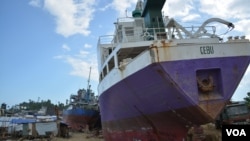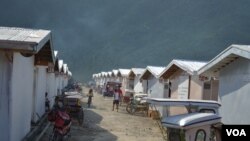TACLOBAN, PHILIPPINES —
Parts of the central Philippines are still struggling to recover from last November’s devastating super typhoon. In the hard-hit city of Tacloban, which suffered the worst of the storm, residents adjust to a life of fewer jobs and fewer people.
Downtown Tacloban’s streets are tight with motorcycle sidecars and double-parked vehicles, and there is a lot of activity on its sidewalks. But a closer look reveals that commerce is dominated by street vendors positioned in front of shuttered establishments. The few grocers and banks that are open have snaking lines outside their doors.
While almost all of the debris that clogged the city is cleared and thousands of dead bodies removed, Tacloban Mayor Alfred Romualdez said the recovery is not moving fast enough - especially for business.
“Since 90 percent of business in Tacloban is trading, I would say the big guys, not even half are in operation… They were very hurt. It caused a lot of damage because of the looting and it’s hard to claim insurance with looting,” said Romualdez.
Romualdez said the biggest mall alone could supply close to 1,500 jobs if only it would reopen. He said about 20,000 people remain homeless and almost all of them were working before the storm hit and churned up a six-meter storm surge that left about 3,000 dead in this city alone.
More than 20 percent of the 250,000 residents here live in poverty. Romualdez said that at the end of the month, Tacloban will unveil its master plan to help mitigate the effects of super storms, which weather forecasters say are becoming the norm.
Four months after Typhoon Haiyan did its damage, water service is available at less than half its capacity; 52 percent of the city has electricity. The city has placed residents in some 1,200 bunkhouses and temporary shelters, but that falls far short of the needed housing.
The shortage can be seen in communities that quickly grew up around what were originally evacuation sites, mostly public schools. Also, seaside dwellers immediately returned and rebuilt their shanties, even if their next-door neighbors are now beached barges and ships.
In Anibong, shanties with blue tarp and corrugated metal roofs are going up behind signs that read “40 meter easement from shoreline is a no-build zone.”
Elsa Solajes and her family have made their living fishing offshore for more than 30 years. She pointed at the massive bow of a red and blue ship that is just behind their recently erected shanty and said that during the storm, the ship destroyed their cinderblock house as they ran to the mountain. It was right on top of their kitchen, wrecking it, she recalled.
Solajes said the family received a donated fishing boat, but they are still short one so their catch is greatly reduced. These residents are also dealing with pitch black once the sun goes down, so their days are shortened.
Romualdez said the city will enforce the 40-meter easement rule and it will move seaside squatters once a housing area further inland is ready to be occupied.
Solajes said she worries about how the family will make a living away from the water.
Further away from the water, in Community 94, Renaldo Viñas, a local councilman, is helping to oversee the distribution of relief goods. He is also a recipient.
The Department of Social Welfare and Development made a delivery one other time after the storm, according to Viñas. The community has mostly relied on international aid.
Viñas lost 11 family members to Haiyan. His motorcycle sidecar fabrication business just reopened in early March. Before that, his family mostly depended on help from relatives in the United States and Manila.
But not everyone is struggling. Back in downtown Tacloban, Giuseppe’s Italian restaurant is doing brisk business with a mostly foreign clientele. The owner Joseph Bonavitacola said just two of his nine food service businesses have reopened. Still, things have been good since two weeks after the storm, even without his regular affluent clientele who have moved to cities like Manila and Cebu.
“We’re doing well and hopefully it stays that way, and these foreign workers stay here for the long term so that, you know, it’s a big help for everybody. A big help,” said Bonavitacola.
Bonavitacola said six months after the storm, he expects most if not all the businesses will be open again and the city “will be fine.”
Downtown Tacloban’s streets are tight with motorcycle sidecars and double-parked vehicles, and there is a lot of activity on its sidewalks. But a closer look reveals that commerce is dominated by street vendors positioned in front of shuttered establishments. The few grocers and banks that are open have snaking lines outside their doors.
While almost all of the debris that clogged the city is cleared and thousands of dead bodies removed, Tacloban Mayor Alfred Romualdez said the recovery is not moving fast enough - especially for business.
“Since 90 percent of business in Tacloban is trading, I would say the big guys, not even half are in operation… They were very hurt. It caused a lot of damage because of the looting and it’s hard to claim insurance with looting,” said Romualdez.
Romualdez said the biggest mall alone could supply close to 1,500 jobs if only it would reopen. He said about 20,000 people remain homeless and almost all of them were working before the storm hit and churned up a six-meter storm surge that left about 3,000 dead in this city alone.
More than 20 percent of the 250,000 residents here live in poverty. Romualdez said that at the end of the month, Tacloban will unveil its master plan to help mitigate the effects of super storms, which weather forecasters say are becoming the norm.
Four months after Typhoon Haiyan did its damage, water service is available at less than half its capacity; 52 percent of the city has electricity. The city has placed residents in some 1,200 bunkhouses and temporary shelters, but that falls far short of the needed housing.
The shortage can be seen in communities that quickly grew up around what were originally evacuation sites, mostly public schools. Also, seaside dwellers immediately returned and rebuilt their shanties, even if their next-door neighbors are now beached barges and ships.
In Anibong, shanties with blue tarp and corrugated metal roofs are going up behind signs that read “40 meter easement from shoreline is a no-build zone.”
Elsa Solajes and her family have made their living fishing offshore for more than 30 years. She pointed at the massive bow of a red and blue ship that is just behind their recently erected shanty and said that during the storm, the ship destroyed their cinderblock house as they ran to the mountain. It was right on top of their kitchen, wrecking it, she recalled.
Solajes said the family received a donated fishing boat, but they are still short one so their catch is greatly reduced. These residents are also dealing with pitch black once the sun goes down, so their days are shortened.
Romualdez said the city will enforce the 40-meter easement rule and it will move seaside squatters once a housing area further inland is ready to be occupied.
Solajes said she worries about how the family will make a living away from the water.
Further away from the water, in Community 94, Renaldo Viñas, a local councilman, is helping to oversee the distribution of relief goods. He is also a recipient.
The Department of Social Welfare and Development made a delivery one other time after the storm, according to Viñas. The community has mostly relied on international aid.
Viñas lost 11 family members to Haiyan. His motorcycle sidecar fabrication business just reopened in early March. Before that, his family mostly depended on help from relatives in the United States and Manila.
But not everyone is struggling. Back in downtown Tacloban, Giuseppe’s Italian restaurant is doing brisk business with a mostly foreign clientele. The owner Joseph Bonavitacola said just two of his nine food service businesses have reopened. Still, things have been good since two weeks after the storm, even without his regular affluent clientele who have moved to cities like Manila and Cebu.
“We’re doing well and hopefully it stays that way, and these foreign workers stay here for the long term so that, you know, it’s a big help for everybody. A big help,” said Bonavitacola.
Bonavitacola said six months after the storm, he expects most if not all the businesses will be open again and the city “will be fine.”









